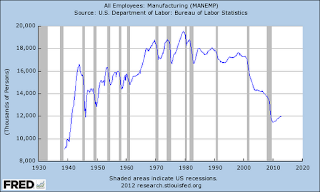"China's history is marked by thousands of years of world-changing innovations: from the compass and gunpowder to acupuncture and the printing press. No one should be surprised that China has re-emerged as an economic superpower." - Gary Locke
It is common belief that China has taken over as the world's top manufacturing country. It is clear that millions of jobs have left the United States (see the first chart below) and have moved to cheap labor hubs such as China and other countries in the East, however the thought that manufacturing in the United States is dead is a misguided opinion. Could there be a resurgence in United States manufacturing and could this be the key to lowering the unemployment rate?
Having been dogged by a high unemployment rate for the past number of years, getting this number lower is of critical importance to the economic strength of the United States. More jobs mean more income to the populous who in turn have more money to spend and therefore buy more goods and services, reviving a weak economy, creating growth and economic strength. As there have been a glut of jobs moved off shore it is felt that creating tariffs and other barriers is in the best interest of the United States but this is to me a short sighted view and I will argue that because of the lack of barriers the United States has once again become one of the world's manufacturing superpowers.
In watching the trends more and more manufacturers are bringing the work back onto American soil for a number of reasons but first and foremost is the ability to remain price competitive. So how is this possible when labor rates are so much cheaper in the East? Through productivity gains meaning more product is produced per person in the United States offsetting the cost per hour and leveling the playing field. As you can see in the next set of graphs that the gains in productivity have continued unabated for years and this is starting to tilt the economic advantage in favor of the United States.
This productivity has lead to a resurgence of manufacturing in the United States which has virtually surpassed the pre-recession levels. In fact taken on its own the value of manufactured product in the United States would make it the 9th largest economy in the world.
Another benefit is that with the productivity comes the ability to pay the workers an excellent wage for their work particularly in comparison to their offshore brethren.
As Germany has proven, it is possible to keep manufacturing healthy even with an expensive workforce as long as you become extremely efficient and continue to improve productivity and it appears on the surface that the United States has embraced this and has returned to a manufacturing superpower. So why haven't the jobs returned?
Now here is the rub, in order to remain competitive the good old production and manufacturing job has gone. There is no way that America (or the rest of the world for that matter) can compete with the wages of the East. When bodies are needed to produce something they have the comparative advantage however when there is a highly skilled manufacturing process required, the West still holds an advantage particularly when you factor in the costs of shipping the product and the potential threat to an infringement on your patented product (having knock offs of your product magically appear on shelves in the East before the actual product even reaches American soil).
For these reasons numerous manufacturers are returning to the United States and are reaping the rewards of short delivery time and low delivery cost plus the social benefit of stamping Made in America on the product. This work however requires a skilled labor force as the bulk of the basic manufacturing work has been replaced with technology in the form of robots and other efficiencies. The good old days of being good with ones hands and therefore finding a job are for all intents and purposes gone from the United States and many other first world economies.
So looking forward while it appears that manufacturing is on the upswing the demand for workers will not come from this part of the economy. Workers will have to attend career colleges (we used to call them trade schools) in order to retool their skills and get back into manufacturing as these jobs now require a heavy dose of mathematics, science and technological know how to become employed. The good news is that these workers should earn a wonderful income for years to come but manufacturing as an employment driver is dead. I believe that this is why there is such an outcry over the loss of unskilled job opportunities. Over time the system will adjust and we will all benefit from the advancement in manufacturing but until then, there will be an extended drag of high unemployment in the United States for far longer than anyone ever anticipated and this drag will be felt throughout the economy for years to come.
Friday, November 30, 2012
Subscribe to:
Post Comments (Atom)






No comments:
Post a Comment